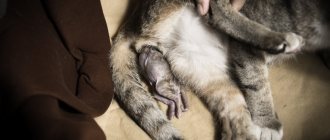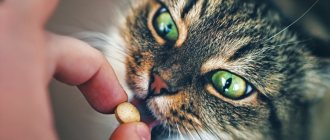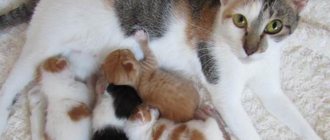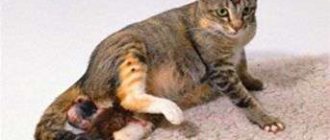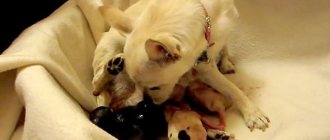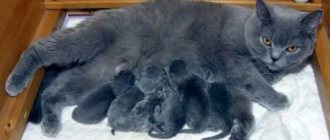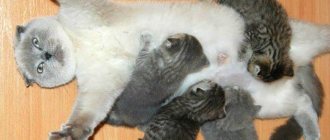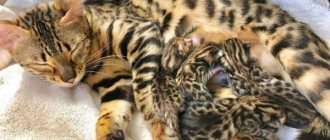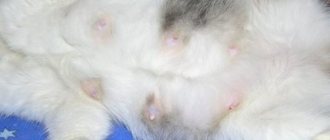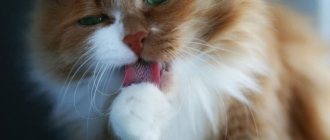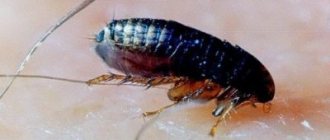Pregnancy and childbirth (lambing) in cats are natural processes characteristic of unsterilized pets. In most cases, they proceed without complications, but sometimes the owner’s help is required. Complications are typical for primiparous, purebred and dwarf cats, as well as for those who are sick with congenital or acquired pathologies. In such cases, mandatory provision of step-by-step assistance is required throughout the entire lambing.
Signs of labor beginning
Pregnancy in cats lasts, on average, 60 days.
But since each organism is individual, it is not possible to predict the exact date of the upcoming birth, even if the pet was purposefully brought together with a cat. The most informative indicator is the following fact: before labor begins, the cat’s water and plug break. Detecting this phenomenon in time can be problematic, since the expectant mother will lick herself, and not every owner will be able to be near her all the time. Therefore, you need to pay attention to other signs of impending delivery:
- within a day or two, the cat’s mammary glands increase in volume and colostrum is released;
- the pet’s behavior changes - it becomes indifferent to food, meows a lot, can show aggression and hide, or, on the contrary, follow the owner’s heels;
- a few days before giving birth, the expectant mother looks for a suitable secluded place for this;
- the cat often licks its stomach and genitals;
- the pet’s body temperature decreases;
- approximately 5 hours before delivery, the animal’s spine acquires a characteristic curve.
Signs that indicate the onset of labor
1–3 days before the onset of labor, you can understand from the cat’s behavior that this moment will soon come:
- The future tailed mother is actively looking for secluded places, every now and then trying to hide in the closet or behind the sofa. Digs there, trying to build a nest. The pet becomes very affectionate, constantly demands attention, and can sometimes be annoying. It rarely happens that a cat, on the contrary, becomes overly aggressive and hides from its owners. Other symptoms:
- at this time, the loop increases greatly, and clear or light pink discharge is observed;
the cat begins to lick itself more often;
- There is a loss of appetite up to complete refusal of food.
- When there are a day or a little less left before lambing, the animal’s body temperature drops to 37°C.
- 4–8 hours before lambing, the animal begins to hunch over. This is how the body reacts to training contractions of the uterus. This process causes great anxiety in the pet; she may complain to the owner, seeking his support. But another option is also possible - she will try to hide.
- 4 hours before labor, the mucus plug comes off. It is a small transparent clot, sometimes it can have a yellowish or greenish tint and include small inclusions of brown, which is considered normal. Often the plug comes out during urination or in parts. But this moment may not be noticed in an overly clean animal.
- When the temperature rises to normal—38–39°C—this means that there are about 2 hours left before birth.
1–3 days before giving birth, the cat persistently demands attention and affection
If a cat experiences premature lambing, then the described symptoms occur almost 2 times faster.
Call a veterinarian immediately if:
- a furry pet carries kittens longer than expected;
- the pet experiences fever, vomiting and convulsions;
- bleeding lasts more than 10 minutes and is accompanied by an unpleasant odor.
Video: signs of the beginning of lambing
Premature birth
Sexual infections, physical trauma, and severe stress are some of the main causes of premature lambing. This problem can occur in older cats or in representatives of breeding and selective breeds who are giving birth for the first time.
Be sure to show your pregnant cat to a veterinarian, and before giving birth, agree with him about help if necessary.
If lambing occurs when the gestation period is 51 days or more, the kittens are considered viable and must be fought for their lives. Call your veterinarian immediately. But under no circumstances try to stop contractions in order to postpone labor until a specialist arrives. You will have to deliver the baby yourself.
If the premature birth was successful and the cat feels fine, still show her to a specialist.
How to behave with a pet
If this is your first time attending the birth of a family pet, then excitement is a natural process. You must understand that when a furry mother goes into labor, she experiences pain, fear and needs support. Your behavior will largely determine the successful outcome of the case. Even if you don’t really understand how to act, control yourself. Get together and provide all possible assistance:
- Try to ensure that no strangers or curious people gather near the lambing area.
- Apart from the owner, there should be no other people in the cat's field of vision, even if they are family members to whom the cat is accustomed.
- Talk kindly to your pet, show her that you are nearby and will not abandon her in difficult times. Stroke it from top to bottom. Speak kind words.
Your participation will calm the cat before giving birth
Preparing for childbirth
You need to thoroughly prepare for childbirth. To do this, you will need not only to arrange the place where the kittens will appear, but also to prepare some tools and materials that may be needed in case of complications that arise. In addition, you should make sure that you have medications on hand and be sure to write down the veterinarian’s phone number so that you can contact him at any time.
Arrangement of the “nest”
A large box is perfect for temporary housing for the mother and her offspring. To make it easier for the cat to climb into it, one side can be made lower than the rest. It is not recommended to make a slot along the entire height of the box to prevent the kittens from escaping.
Mother cat with her kittens
The bottom of the box can be covered with a rubber or foam mat, or a piece of similar material, oilcloth. This will protect the cardboard from accidental wetness. Place a cloth or disposable diaper on top.
It is advisable for the box to stand in the place chosen by the cat, but, in most cases, mustachioed mothers prefer closets or the owner’s bed. The place where the box will be placed should be quiet, warm, and secluded. You need to gradually accustom your pet to the “nest” by placing drinking water and food nearby. In the end, she will understand what is required of her and will accept the proposed option.
Preparing tools
By the time of birth, items should be prepared that may be needed if the situation takes an unexpected turn:
- scissors;
- sterile rubber gloves;
- Vaseline oil;
- antiseptic (brilliant);
- syringe;
- dishes for clean water;
- cotton buds;
- threads;
- syringes of different sizes;
- disposable diapers;
- pieces of cotton fabric (they must be pre-washed and ironed).
All accessories must be in one place and in “combat readiness”: clean and disinfected.
Medications
In some cases, your mustachioed pet may need medical assistance, so in addition to the tools, you should prepare some medications.
- Oxytocin. It will help with a sudden cessation of contractions or weak labor. Promotes contraction of the uterine walls. Used as injections into the withers area in a dosage of 0.2 ml.
- Travmatin. As soon as the woman in labor begins, you can give an injection of this drug in a dosage of 1 ml. After the end of childbirth, the drug is used for the next three days, one injection per day. Travmatin eliminates pain, prevents the development of the inflammatory process, has an antimicrobial effect, and reduces the likelihood of infectious complications.
- Calcium gluconate. In the form of an injection solution, it is used in a dosage of 1 ml for the normal course of labor and the prevention of eclampsia.
Search for arranging a place for childbirth
If the cat becomes restless and hides, then it’s time to choose a place to give birth. She will definitely choose it herself, but these may be unacceptable, from the owner’s point of view, locations - for example, in a wardrobe or in a pencil case in the kitchen.
The owner of the cat needs to outline in advance a list of places in the apartment that are inaccessible for childbirth.
To choose the right place, they are guided by the instincts of the animal. The following requirements are imposed on the “maternity room”:
- privacy from prying eyes;
- absence of drafts, dampness and cold (recommended temperature is 29–30 °C);
- shading.
The room should be warm enough so that the kittens do not get sick.
Attention! In cold rooms, the risk of kitten hypothermia (body temperature drops below 35 ° C when the norm is 38.5–39.5) and aspiration pneumonia increases. This leads to impaired respiratory function and death of babies.
Dishes with drink and food are placed not far from the chosen place, since the woman in labor will not be able to leave her offspring for a long time.
Another criterion by which a place for childbirth is looked for is accessibility for a person. After all, the process does not always proceed without problems; sometimes animals require the help of the owner or even a veterinarian.
The bedroom is one of the most suitable places in the house for a giving birth cat.
Experienced breeders advise: all corners where it is impossible for a person to penetrate in order to control the process are blocked. The optimal place that cats prefer in the house is the bedroom.
If there are other animals in the home, exclude their access to the offspring for the next few weeks after birth. In addition, contact with them increases the risk of the spread of bacterial and viral infections, which can lead to the death of the offspring and the woman in labor, whose body is extremely weakened during this period. Remove cosmetics and household chemicals to prevent poisoning.
Delivery box
The simplest option for a “maternity hospital” is a large cardboard box with sides no less than 60 cm. After all, a cat and her litter will spend at least a month here. If the space is crowded, kittens may get injured.
When choosing a cardboard box, don’t settle for compact models - kittens need space
The box must include:
- a removable lid to allow access to residents when assistance is needed and to the contents for cleaning;
- an entry hole at the level of the cat’s chest - this will make it easier for the female to get inside, but will not allow small kittens to crawl out;
- you can make several “outbuildings” - a dining room and a toilet, where you can place food and a tray with filler.
In a cramped box, a cat runs the risk of miscalculating her efforts and accidentally crushing the kittens.
Both the hole and the removable cover are required. If a cat sneaks into the house from above, it can crush the kittens.
The top of the box is reinforced with tape, covering the joints. Decorating the building is not recommended. The products that are used - paints, varnishes, polymer materials - can scare away the cat with the smell.
Drawing of a cardboard house for giving birth to a cat
Experienced owners say that a cat giving birth for the first time may not understand why the box was placed. They advise leaving the animal alone until delivery. When the process begins, the female just needs to be carefully moved into the box.
The fact that childbirth is approaching will be warned by the release of the mucus plug, which covered the entrance to the uterus during the entire period of gestation.
If you do not plan to sterilize the cat, then it is better to acquire more reliable structures - for example, made of plywood, or exhibition tents.
Plywood birthing houses are well suited for large breeds.
Some breeders recommend preparing not one, but two houses at once. In the second, newborn kittens are placed until the female reproduces all the offspring. Then the babies are transferred to their mother.
Heating
The place where newborn kittens will be located for the first weeks of life must have a constant temperature. Temperature changes can adversely affect the health of kittens and weaken the immune system.
Hypothermia or overheating of newborns is unacceptable
Infrared lamps
Infrared lamps will help warm the air to the required level. Infrared radiation is credited with healing properties - stimulating blood flow, enhancing regenerative function, strengthening the immune system, and others. They are installed next to the maternity hospital. The light flux is directed to one of the walls. So, if the kids are hot, they will move to another part of the box. The lamps are installed at a height of 40–50 cm from the heating surface to the bottom of the house.
Infrared lamps are also used for heating young animals in agriculture
To make the device more convenient to use, lampshades with switches and a cord with a plug at the end were developed. A protective mesh can be placed on the bottom of the device, which prevents the animal from touching the surface of the lighting device.
Infrared lamps come in bulb and halogen types. The second type of IR lamps has a longer service life. Breeders who are engaged in breeding cats should pay attention to them. Another advantage is that this lamp does not burst when it hits the surface of water.
In addition to maintaining warmth, infrared lamps have a positive effect on the well-being of newborns
Alternative Warming Options
Electric mattresses can be used as an alternative to IR lighting. They ensure uniform heating of the entire area of the house - almost an analogue of a “warm floor”. Some of them are placed in a case made of waterproof fabric. Thanks to this shell, you don’t have to worry about the product getting dirty. Some models are equipped with a timer, which saves energy.
In the absence of more complex heaters, it is permissible to use ordinary heating pads
If neither one nor the other is at hand - for example, when a stray cat giving birth was picked up on the street, then bottles of warm water wrapped in disposable diapers or ordinary rubber heating pads will do.
Litter
In the birthing house, a soft mattress is laid in 1–2 layers. Pet stores sell ready-made products of different sizes to suit every taste. It is also acceptable to use an old unnecessary blanket. The surface is covered with disposable films, which are changed at least once a day. In the compartments where the drinking bowl, food bowl and tray are installed, waterproof or ordinary films are placed.
Disposable diapers should significantly simplify the process of childbirth
How does childbirth occur in cats?
Conventionally, there are three stages of delivery in cats.
Stage
What's happening
1
Immediately before giving birth, the cat becomes restless. Her mouth may be open, she is breathing heavily, and meowing. Small amounts of bleeding may occur. Since contractions are already beginning, the movement of the kittens can be determined by the surface of the abdomen - they take a position one after another, turning their heads towards the exit. This stage lasts from 5-12 hours to a day and a half (often during the first birth).
2
A kitten is born. Each may take 5-30 minutes. The break between the first and second baby is longer than the others, then the kittens follow each other.
3
The placenta comes out after the kitten.
The immediate appearance of offspring occurs as follows:
- the animal pushes, helping the kittens move out;
- a kitten appears, it can come out both in the amniotic sac and without it (in the process of passing through the birth canal it often bursts);
- the mustachioed mother herself removes the remains of the bladder from the cub, and then licks it, clearing the airways;
- the woman in labor does not immediately gnaw the umbilical cord, but when the placenta comes out (it is important to count the placenta so that there are as many of them as there are babies, the placenta remaining in the uterus is a source of infection);
- the baby attaches to the nipple.
The cat usually eats the afterbirth. Placental tissue contains hormonal compounds and biological active substances that ease contractions, promote milk production, and have a positive effect on the recovery of the pet after childbirth. But you don’t need to give her more than 2-3 - vomiting or diarrhea may occur.
Attention: a newborn baby should squeak after being licked by a cat. If this does not happen, you need to check whether he is breathing and, if necessary, take appropriate measures.
How to deliver babies of varying degrees of complexity at home
Assistance to the woman in labor depends on the severity of the lambing. It is impossible to predict its outcome in advance, so you will have to act according to the situation.
Lungs
For mild lambing, no intervention is required. You just need to ensure the safety of newborns. During labor, the mother may crush them, so place the kittens in a separate box until the last baby appears.
Compare the number of newborns and placenta. The lack of placenta is caused by getting stuck inside the womb, leading to inflammation. You will have to remove it yourself by wrapping your fingers in a clean bandage. If pus, mucus or blood appears, lambing is considered moderate or severe.
Average
At the end of labor, the new mother independently gnaws the umbilical cord, eats the afterbirth and cleanses the newborns of mucus. If she did not do this, you will have to play the role of an obstetrician. Carefully cut the umbilical cord 4 cm from the abdomen, tie it with thread and treat the wound with an antiseptic.
Before cutting the umbilical cord, remove membranes from each kitten and clean their nasal passages and mouth using a pipette or bulb. If there is no breathing or a characteristic squeak, carefully fold the baby in half, rub him with a towel and gently shake him upside down.
Do not give your pet more than two afterbirths. They are rich in beneficial microelements and have a beneficial effect on the immune system, but cause gastric upsets if consumed in excess. If the bubble does not burst inside the vagina, the pet may try to burst it along with the kitten. Discourage this action by noticing a bubble emerging from the vagina. After the newborn arrives, carefully open the amniotic sac, being careful not to touch the tiny body.
Complex
Complex cases include stopping labor. This can happen when the fetus gets stuck or several babies are pushed out at the same time. To save them, you will have to wear disposable gloves, lubricate your fingertips with Vaseline and carefully insert them into the vagina in an attempt to grab the withers. Avoid paws. They are too fragile and can be easily damaged. Pull your newborn out using gentle rocking movements.
If you notice an unpleasant-smelling brown fluid coming out of the vagina or prolonged labor, you should contact your veterinarian. It is also recommended to clarify in advance the number of future offspring using an ultrasound scan, so as not to miss the stuckness of the fetus.
Features of the first birth
The first birth is stressful for a cat. You should not rely only on nature, as the situation can get out of control. It is important that all necessary materials, medications and instruments are ready at the time of delivery.
During childbirth, the cat needs to be supported morally: talk to it, calm it down, stroke it. There are also cases of cannibalism among felines, so you need to monitor your pet’s behavior when kittens appear. It happens that a tired mother in labor crushes the newborn kitten with her body or does not want to lick it. Then the owner will have to remove mucus from the baby’s respiratory tract with a syringe.
A situation often occurs when kittens are born not with their muzzle forward, but with the back of their body, or “get stuck” in the birth canal. There is no place to wait for help at such moments, so the owner must know how to deliver a cat and what needs to be done in critical situations.
Induction of labor
If the due date has come, the cat’s body temperature has dropped to 37°C, more than two days have passed, then you need to know how to induce labor in a cat. First, they try simple remedies: massage the tummy and nipples: this will cause the production of oxytocin, and it will start the process of contractions. It is dangerous to administer oxytocin on your own - physiological unpreparedness for lambing can lead to cervical rupture.
If two days have already passed, signs of labor are evident, but the process has not started, then contact a veterinarian.
Problems that may arise when giving birth to a cat
The table below highlights the most common problems that arise during the birthing process in cats and kittens, which the owner can overcome on their own.
Stage
What's happening
Contractions have stopped or become weak
You need to wait some time. When 1-2 kittens are born, labor may subside and then reactivate (in some cases it can take up to a day). Labor can be stimulated by massaging the mammary glands and nipples. In extreme cases, it is possible to use oxytocin, a drug that promotes contractions of the uterine wall. It should be borne in mind that improper use of the product can cause the death of the mother and offspring.
The membrane remained intact
If the mustachioed mother has not torn the membrane of the amniotic sac, you need to carefully tear it apart, starting from the kitten's face.
The cub can't get out
If the baby gets stuck in the birth canal, the owner will have to help him: to do this, grab the kitten by the skin (on the withers or back of the body) and slowly pull it out. Manipulation should be carried out wearing gloves, the tips of which should be lubricated with Vaseline oil.
The umbilical cord remained intact
If the woman in labor has not gnawed the umbilical cord, and more than a quarter of an hour has passed since the kitten was born, it is necessary to do the following: step back from the kitten’s tummy about 4 cm, bandage or clamp it, and after half a minute cut it at the point of compression. The incision site must be treated with an antiseptic (brilliant).
Newborn is not breathing
You can try to gently shake it, lowering its muzzle down. A sign of oxygen entering the respiratory system is the pink color of the newborn’s tongue. In addition, it should make a squeaking noise.
Cat ignores baby
In this case, the owner must carry out the initial treatment of the kitten. It is necessary to wipe the newborn with a cloth and remove mucus from the respiratory tract using a syringe. After this, you need to place the baby on the nipple.
When to Call the Vet
During childbirth, the owner needs to closely monitor not only the release of the kittens, but also the placentas. If the number of placentas is less than the number of kittens, then you should seek help from a veterinarian. Below we provide a complete list of situations in which the help of a specialist would be appropriate:
- The duration of the attempts exceeded half an hour, but the first kitten was never born.
- In case of premature birth, a call to the veterinarian is strictly necessary. The normal period is considered to be 59-70 days after conception.
- Heavy bleeding during labor, the blood is bright scarlet in color. This may indicate a rupture of internal tissues, and in this case, the help of a veterinarian cannot be avoided.
- In some cases, it is advisable to induce artificial labor, but such a decision should only be made by an experienced specialist.
- You need to call a veterinarian if, a day after giving birth, your cat develops vaginal discharge with a characteristic unpleasant odor.
- Inflammatory reactions have begun in the mammary glands, the nipples harden.
- During lactation, a few days/weeks after birth, the mother developed an elevated body temperature.
- The kittens are cold and hard - we immediately look for the phone number of the nearest veterinary department.
In what cases should you urgently contact a veterinarian?
During childbirth, critical situations may arise that can only be resolved in a clinical setting. This:
- More than a day has passed since the first contractions;
- it is not possible to independently remove a stuck kitten from the birth canal;
- there are no precursors of the onset of labor, although more than 65-70 days of pregnancy have already passed;
- the cat has a high or, conversely, low body temperature;
- the animal does not strain or move, breathing is weak;
- contractions are strong, but the kitten does not appear;
- unpleasant-smelling contents mixed with pus and blood are released from the birth canal.
Medicines
Before the cat gives birth, it is necessary to prepare a number of medications necessary both to stimulate labor activity and for disinfection and antibacterial treatment of newborns.
To speed up labor
If labor is good, then medications are not needed. But in case of complications, on the recommendation of a doctor, veterinary medications can be used to stimulate the process.
Table 1. Drugs that accelerate cat labor
| A drug | Method of administration | Description |
Travmatin | Intramuscularly or subcutaneously 0.1 ml/kg animal weight or orally 5–15 drops | The drug activates the production of oxytocin, which increases uterine contractions. The manufacturer claims an analgesic, anti-shock, hemostatic, anti-inflammatory, and tissue regenerating effect. The product is recommended after any surgical interventions. It is also prescribed for large fetuses and large litter sizes, in case of severe bleeding |
Gamavit | Intravenously, intramuscularly or by drinking. The dose depends on the weight of the animal | A complex remedy that normalizes labor and cleanses the uterus of a dead fetus. In addition, the drug increases the survival rate of offspring |
Oxytocin | Subcutaneously, intramuscularly, intravenously. The dose is determined individually | Indicated for conditions such as atony and hypotension of the uterus, endometritis, uterine bleeding, weak labor, and retained placenta. Please note that the product is available in dosages of 5 and 10 units, so you need to calculate the dose for a cat manually |
Incorrect or unreasonable use of veterinary drugs can seriously harm the health of the mother in labor.
Another remedy that breeders talk about is a cocktail to induce labor. It is called the safest of the list. Prepare it yourself from the following components:
- glucose, sodium gluconate - 4 ml each;
- vitamin C - 2 ml.
The optimal place for subcutaneous injection of a “cocktail” to speed up labor is at the withers
Mix all components in a 10 ml syringe. For one injection, take 1 ml/5 kg of the cat’s weight. The mixture is administered subcutaneously after the birth of the first kitten.
The cocktail has a multifaceted effect:
- maintaining the uterus in tone;
- better yield of clots;
- nutrition;
- stimulation of milk production.
Before using medications to help your cat give birth, consult your veterinarian.
Before giving birth, it is recommended to discuss with your veterinarian the possibility of using all of the above remedies. Based on the animal’s condition, the specialist will choose the best drug and show where and how to inject.
You can also read about how to deliver a cat on our portal.
Video - How to inject the solution subcutaneously into a cat
Other drugs
In addition to the above drugs, the first aid kit for childbirth includes disinfectants - iodine or brilliant green. These drugs are used to treat the tip of the umbilical cord.
The umbilical cord is disinfected using iodine or brilliant green
You will also need:
- sterile petroleum jelly to facilitate the exit of the fetus from the birth canal;
- ammonia for resuscitation (the product is dripped onto cotton wool and brought to the kitten’s nose);
- glucose, saline solution (the first to lubricate the nipple, the second to lubricate the kitten’s mouth), drugs are used if the cub does not attach to the mother’s breast;
- chlorhexidine for hand disinfection.
How to find out if all kittens are born
A situation may arise that after the birth of the first kittens, labor seems to have stopped. However, a lull does not mean that all the cubs have come out - the cat may take a “break” from fatigue. A sign of ongoing labor is ignoring the kittens. The duration of the break varies. The alarm should be sounded if a woman in labor does not pay attention to her offspring for a long time, her temperature rises, she does not get up and does not push.
You can check whether the babies are still in the uterus by feeling the cat’s belly. As a rule, palpation allows you to accurately determine the presence of a kitten in the womb. If the test is positive, you need to wait some more time, and if labor does not continue, contact the clinic.
How does the process of giving birth to kittens take place?
How cats give birth: after how long and how long does labor last?
Childbirth is a painful process, and it is possible that the cat may bite the “helping hand,” so you should not bother with the woman in labor again. If everything goes well, then she doesn’t need help with the birth at all.
Important! Kittens can be born head-first or rear-footed, both of which are normal.
How does this happen:
- The onset of contractions may not be noticed, but during them the cervix opens.
- The uterus continues to contract, and those kittens that are far away in the uterus “push” their brothers and sisters towards the “exit”.
- The birth of a kitten occurs in one or two contractions. The kitten is born with an umbilical cord and placenta.
- The mother gnaws the umbilical cord. If she is unable, then you should help her with sterile scissors.
- The time difference between the birth of kittens is half an hour to an hour. If there are no kittens for a long time, but the owners are sure that more will be born, this is a reason to consult a doctor.
The structure of a cat's uterus differs from that of a human - kittens are attached both in the ovarian tubes and in the body of the uterus itself.
Note! It is necessary to monitor the number of afterbirths. There should be as many of them as there are kittens. If the birth is over, but not all the placenta has come out, you should visit a veterinarian without delay.
1-2 afterbirths can be given to a cat to eat; they contain a lot of vitamins, hormones and nutrients. It is better not to feed all afterbirths, since an excess of hormones causes vomiting and diarrhea.
Between the birth of kittens, the cat actively licks them, and the kittens crawl to the breast to feed. If a cat ignores its children, you can put them under its nose and to its stomach, but you should not insist too much. The mother may be very exhausted from childbirth, and she simply has no time for kittens.
The structure of the cat's reproductive system
End of labor
Labor can be considered completed if more than 2 hours have passed since the last contractions. A cat after giving birth behaves as follows:
- her breathing is restored - it becomes smooth and calm;
- she shows an active interest in newborns - licks them, turns them over;
- takes a different position, adjusts to the kittens in order to feed them;
- feels thirsty and hungry;
- goes to the toilet.
It is undesirable to pick up kittens; some mothers refuse to accept the cubs after this. The place where the birth took place needs to be put in order. To do this, the mother and offspring are carefully moved to a temporary bedding and returned back after cleaning. To prevent the pet from leaving the kittens for a long time, it is better to place the tray and bowls nearby.
What is needed for childbirth
It is necessary to prepare everything for childbirth in advance. Here is a complete list of what may be needed in case of emergency, although it is quite possible that nothing else will be needed besides the box, because almost every cat gives birth on its own.
- Soft and cozy box.
- Sterile gloves.
- A syringe to remove discharge from the kitten's nose and mouth.
- Clean cloths and towel. You can use toilet paper.
- Scissors.
- Antiseptic drug.
- Telephone for urgent calls to the doctor in case of complications in a giving birth cat.
- You may also need a cat milk replacer.
How to care for a cat after giving birth
The postpartum period is important both for the recovery of the mother and for the development of kittens, which will be with their mother for another 1-2 months. First of all, the pet must be provided with high-quality, high-calorie and balanced nutrition.
What to feed a cat after giving birth? If the animal was initially fed industrial feed, then you need to choose formulations that are suitable for nursing mothers with a mustache. In the case of a natural diet, the first two weeks, preference should be given to foods that are easily digestible: broth, lean meat, sour cream, porridge, cottage cheese, milk. Subsequently, fish and other usual foods are introduced. You need to feed your pet at least 5-6 times a day.
Postpartum care
Special attention and care should be shown to the pet not only at the time when the cat gives birth, but also in the postpartum period. Giving birth to cats takes a lot of energy, and a loving owner should understand this.
When a cat gives birth for the first time, at the very beginning it is necessary to make sure that all the kittens are born and that there is nothing left in the womb. And if when a cat gives birth, sometimes human intervention is needed, then now it is better to leave her alone, only taking care of her nutrition.
It will be useful to take your pet to the veterinarian so that he can rule out mastitis and metritis, which can appear when the cat gives birth and after that. They are often signaled by a temperature elevated to 39.4°. If these diseases are nevertheless diagnosed, the babies will have to be fed by the owner.
Some owners take their pets outside during the postpartum period. It is better not to do this, the animal may become pregnant again. And when a cat gives birth, the body is depleted. Therefore, it is better to avoid such matings.
Postpartum problems
Childbirth is behind us, but the owner must remain vigilant - the cat may develop new problems. The table shows the most common ones and ways to solve them.
Problem
What to do
The cat refuses to eat
Immediately after giving birth, the cat may not ask for food for up to 6 or more hours due to the afterbirth eaten. If you fast for more than a day, you can give her low-fat broth; it contains extractive substances that stimulate the digestive activity of enzymes and the functioning of the gastrointestinal tract. If you have an intestinal disorder (may occur due to a large amount of afterbirth eaten), you need to give the pussy sorbents. When the mother's condition stabilizes, she will develop an appetite. It is important that she drinks water while refusing food.
The animal does not visit the litter box
In the first four days after giving birth, the cat may not want to go to the toilet. This is a normal phenomenon associated with the formation of milk and the restoration of internal organs, which requires a lot of fluid.
There is a discharge mixed with blood
If the volume is small, a cat’s discharge within two days after birth is considered normal and goes away on its own. You need to sound the alarm if the discharge has a pronounced scarlet color, lasts more than two days, or intensifies. This may be a sign of internal uterine bleeding or the presence of serious tissue ruptures. The cat should be taken to a veterinarian immediately.
A woman in labor has no milk
There can be many reasons for this phenomenon - from the cat’s stressful state to internal endocrine disorders. It is important to provide the new mother with complete peace: care should not be excessive. There is no need to move the box with the family to a new place or pick up the kittens. It is necessary to ensure that they are not disturbed by other pets or children. If bowls of food and drink, as well as a tray, are located far from the place where the cat and kittens are located, the pet may worry about the cubs, leaving when necessary. In addition, for a cat to have a sufficient amount of milk, its diet must include dairy and fermented milk products and water.
All that's left is the belly
First of all, it is necessary to exclude the possibility of the presence of a kitten in the uterus, while a dead fetus poses a great danger. You can independently determine its presence by palpation, but it is better to go to the clinic and do an ultrasound. In the absence of a fetus, the cause of the abdomen may be intestinal disorders, helminths, or difficulty with defecation.
An empty bubble came out
The amniotic sac may rupture as the kitten passes through the birth canal, or the cub may be born in it. In some cases, the membranes are expelled before the kitten is born. You can't let the cat tear it apart before the baby arrives. An emerging bladder without a fetus after delivery is not considered a pathology and does not pose a danger to the animal - it is a physiological feature.
Signs of eclampsia appeared
Eclampsia is a phenomenon based on calcium deficiency in the cat’s body. Symptoms: increased salivation, poor coordination of movements, anxiety, increased body temperature, convulsive muscle contractions. This condition leads to the death of the animal, so at the slightest sign you need to urgently take the cat to the clinic. A preventive measure is to take calcium-containing products during the period of gestation and feeding of kittens.
Possible complications
Cats are naturally strong creatures, but sometimes complications still occur. This was especially influenced by breeding selection. Observations have shown that Persian and Siamese cats often “delight” their owners with dystocia—difficult childbirth. When choosing a female kitten, it is better to immediately ask the breeders how the birth of kittens for this particular breed goes.
Bloody discharge in a cat after birth
Sometimes during labor a cat notices ichor oozing out. This is most often described as “my cat peed blood.” This is quite normal if there is little bleeding.
The alarming symptom normally disappears completely two days after lambing.
Sometimes there are really serious problems, expressed by bleeding from the vagina. Blood may have accumulated in the uterus, or if there are tears in the uterus or vulva. If a caesarean section was performed, then the blood may indicate broken sutures. But this is not just some bleeding, but really heavy bleeding that does not stop after 10 minutes. In this case, urgent veterinary help is needed.
The cat does not have milk after giving birth
First, felines, like humans, secrete colostrum. But when does a cat produce milk after giving birth? Colostrum is milk, only with a slightly modified composition. Colostrum contains a huge amount of maternal antibodies. After 2-3 days, colostrum is replaced with full-fledged nutritious milk. Thanks to nature, which, through the process of evolution, “thought out” everything, and the cat itself feeds its offspring!
But what if the cat gave birth, but there is no milk? There are several reasons: stress during a difficult birth, fear of the first-born cat, dormant maternal instinct.
The animal is provided with a comfortable environment, a nutritious, balanced menu, and milk is not spared. The bowl with food and drink is placed closer to the cat family. If food is far away, the mother may fear for her offspring, which also affects the quality and quantity of milk.
If milk does not appear, you will have to feed the newborn kittens yourself.
After giving birth, the cat came out with a bladder
Sometimes you can see a bubble coming out of the cat. Usually, this is the amniotic membrane - the kitten was in it before birth. During the normal course of labor, such a bubble ruptures inside the animal.
Sometimes during labor a bubble appears first. The cat may try to tear it apart, but the owner’s job is to prevent her from doing this. As soon as the bubble with the kitten comes out completely, you can break the shell.
If after giving birth a cat has an empty bladder, this is simply a developmental variation within the cat’s body, and it does not cause problems.
After childbirth there was a belly
global $ads_google;
//data-ad-slot=”2475549904″ $ads_google = empty($ads_google) ? false : true; ?> if ($ads_google == false) {?> $ads_google = true; ?> } ?> The cat has become a mother, the kittens are snoring nearby, but the pet still has a belly. This is the probability that not all babies were born at once. It is optimal to wait 12 hours and allow the natural process to take its course. But if the next day has already arrived and nothing has happened, then you definitely need to consult a veterinarian.
To make sure that not all the babies have come out, the cat’s stomach is felt. It is especially dangerous if the kitten is dead inside. If the baby inside cannot be felt, there is a possibility that the pet has intestinal problems: constipation, flatulence, feces, helminthic infestation.
Eclampsia in cats after birth
Eclampsia is a severe postpartum condition that is not that rare. Due to the production of milk, the amount of calcium in the animal’s blood decreases, and it may even cease to be absorbed by the body.
Signs of eclampsia:
- excessive saliva production;
- poor coordination of the animal, confused movements;
- concern;
- convulsions;
- the temperature rises.
If you notice these warning signs, contact your doctor immediately! Further development of the complication leads to death.
To avoid such danger, during pregnancy and after the birth of kittens, the cat is given calcium supplements. But first, they take a blood test to determine the need for such prevention.
Cat doesn't eat after giving birth
The norm is that a cat should not be hungry for another 5-6 hours after birth.
The main thing is that the pet does not refuse water. If the cat has not eaten for a long time, first she is offered broth. Low-fat cottage cheese, kefir, and even sweet tea can cause your pet’s appetite.
If your cat develops diarrhea, it means she has eaten too much afterbirth. With such a disorder, refusal to eat is understandable. The treatment will be sorbents and Ringer's solution. This will relieve intoxication. Enveloping substances will help protect the mucous membranes. Ringer's solution will prevent dehydration.
As soon as the cat feels better, she will ask for food herself.
The cat does not go to the toilet after giving birth
The body and uterus will gradually recover after the end of labor, so the animal does not rush to the tray. Don't panic if you brought the tray closer to her and the new mother ignored it.
It is considered normal if the cat does not go to the toilet after giving birth for up to 4 days.
The lack of desire to visit the latrine may be caused by exhaustion - all the liquid goes into the milk.
Is it possible to sterilize a cat during childbirth?
If a cat undergoes a cesarean section according to indications, the question arises whether it can be sterilized immediately. Operative delivery in itself indicates problems in the reproductive activity of the animal, so a repeat pregnancy, as a rule, becomes undesirable. At the same time, it is impossible to carry out sterilization and childbirth at the same time - such an intervention poses a threat to the health and life of the cat. It is better to sterilize your pet after 3 months from the date of delivery.
In most cases, the cat is able to cope with childbirth on its own. However, there are also artificially bred feline breeds whose bodies cannot withstand such stress without outside help. The owner's participation in the cat's labor reduces the risk of postpartum complications in the mother and ensures healthy offspring.
Signs of pregnancy
A cat's pregnancy lasts about 9 weeks. Kittens born 7 days earlier do not always survive. Therefore, it is necessary to treat the “future mother” as carefully as possible so that the cat’s pregnancy passes without complications.
In the first 3 weeks, the female becomes calmer, and her actions are measured. Appetite decreases and the cat may begin to vomit. The nipples acquire a pink color, the shade is especially saturated during the animal’s first pregnancy, then it may even have a reddish appearance. At week 5, the embryos become larger and can even be felt through the furry pet’s tummy, which can already move. But in no case should you put too much pressure on the cat’s abdominal cavity - your careless actions can harm the kitten’s health or even provoke a miscarriage. It is still impossible to tactilely feel how many kittens are in the womb.
After the 5th week, the pet’s belly increases sharply, and the embryos in the animal’s body also grow and develop quickly, but the opportunity to feel their heads separately appears only after the 7th week. From that moment on, the caring “future mother” is restlessly looking for a nest for her babies. The cat begins to eat a lot.
By week 9, the mammary glands become larger and large nipples stand out. The female becomes a little withdrawn. A thick fluid may appear near the vulva. Soon the cats give birth.
What to prepare before giving birth to a cat
For comfortable bearing of kittens and their comfortable maintenance in the first weeks after birth, the cat should create all the conditions and prepare a cozy nest. It is best to place this place in silence, away from a noisy room and children, otherwise the cat will look for another place for itself and the kittens.
It is also necessary to organize a spacious maternity area in which the mother and kittens will stay for about two months.
What to do when a cat gives birth?
Most cats give birth to kittens on their own without the help of their owners. However, sometimes the owner still has to give birth to a pet, since his inaction can lead to adverse consequences. The owner should help the animal during labor in the following cases:
- the baby’s head has not appeared after 4-5 strong attempts - lubricate the rounded edge of the pipette with Vaseline , insert it into the vagina, expand it, trying to see where the fetus is and at the same time stroke the mother’s belly in the direction of expulsion;
- the baby was born in a pouch , and the cat does not pay attention to it - open the bubble with scissors, remove mucus from the nose and mouth;
- the baby is not breathing - rub it with a towel in the back and chest for 3-4 minutes. If this does not help, then take the kitten by the legs and shake it upside down, tap its chest, and clear the airways. However, when the next baby appears, resuscitation measures must be stopped, the non-breathing one should be wrapped in a towel and placed under a lamp. Only after making sure that the newborn is in normal condition can you return to resuscitation of the previous kitten.
Newborn kittens
How can you tell when labor is starting?
You can understand that a cat has begun to give birth by such a main sign as the appearance of contractions. They begin several hours before the event and gradually intensify so that they can be seen without palpation. When contractions begin, the woman in labor should be taken to a place prepared in advance and calmed down.
Further, the following signs indicate that labor has begun:
- lowering of the abdomen;
- increased urination;
- mucus secretion;
- breaking of water;
- rapid breathing.
Childbirth
What to do when childbirth has complications
While minor problems during childbirth in a cat can be dealt with on your own, serious complications require immediate medical intervention. It is necessary to urgently call the veterinarian or take the woman in labor to the clinic in the following cases:
- the female carries the babies for more than 70 days, and there are no signs of their birth;
- the first stage of labor lasts more than 24 hours;
- strong contractions last more than an hour, but the baby does not come out;
- the newborn is stuck in the genital tract, and independent attempts to remove it were unsuccessful;
- strong discharge from the genitals appears (bloody, purulent, liquid with an unpleasant odor);
- the cat’s temperature has risen above 39.5 or dropped below 37 degrees;
- the animal makes no attempt to push the kitten out, lies motionless and breathes weakly.
In case of serious complications, it is better to take the cat to specialists
If any troubles arise during the delivery process that the owner cannot cope with on his own, it is better to contact a specialist - inept or incorrect actions can cause serious harm to the animal.
Childbirth in cats is a natural process that usually does not require human intervention, and the correct behavior of a female is inherent in her genes by nature itself. However, the presence of a beloved owner will provide good moral support for the animal, as well as a guarantee that the babies and their mother will endure this important process normally.
Stages of pregnancy
Cat pregnancy is usually divided into several stages:
- Stage 1 – the first three weeks of pregnancy. The mammary glands and genitals become swollen, cats begin to sleep more, there is no appetite as such, and activity is zero. The animal requires attention, sleeps with the owner, clinging to him, the animal may have a gag reflex when eating, or an increase in the size of the uterus upon palpation.
- Stage 2 – from the fourth to the sixth week. The kittens begin to become active and move. The expectant mother has a good appetite and gets plenty of rest. A cat may refuse its favorite food and prefer dairy products. If your cat is vomiting, it is best to take it to the vet.
- Stage 3 – six to nine weeks. Kittens move actively, this is best noticeable when the animal is sleeping. The abdomen is large, the mammary glands are enlarged, colostrum may be released. Hair falls out on the cat's belly, internal organs are displaced due to the large size of the kittens. The cat moves carefully, tries not to jump too much, and sleeps on its side. To prevent the pet from gaining excess weight, it is transferred to fractional meals (4-5 times a day).
Unpleasant consequences after childbirth
Unfortunately, childbirth does not always go smoothly; various unpleasant consequences can occur. So, the first thing you need to pay attention to after childbirth is discharge. Any colored, unpleasant-smelling discharge is a deviation from the norm. If a cat has intense pink discharge, this is a sign of a fungal disease of the genital organs. If they are green, there is a bacterial infection. If the discharge is black-green with a strong unpleasant odor, it means rotting. If they are cloudy yellow or yellow-green, there is purulent inflammation in the womb.
Watery discharge is possible, which may be caused by blood accumulation in the uterus, uterine rupture, or rupture of sutures (during caesarean section).
If after birth the bleeding does not stop for 15 minutes, you should urgently take your pet to the veterinarian and provide qualified assistance.
Another problem after childbirth may be the lack of milk. The reason may be the stress of the mother in labor, so you should create comfort and ensure peace of mind for the mother, feed her well and let her drink milk.
It often happens that after giving birth a cat is left with a hanging belly. The reason may be that there is a dead kitten in the stomach. You need to carefully feel the cat's belly and take the animal to the veterinarian.
After giving birth, it is best to feed a cat with easily digestible food, milk with the addition of fish oil and calcium. Water supplies must be constantly replenished.
Which cats need help during childbirth?
Ideally, preparation for childbirth in a cat should begin even before pregnancy - she should undergo a preventive examination by a veterinarian, after which the owner needs to find a healthy cat for mating. In addition, you need to take care of proper nutrition, vitamins and medications that the animal may need, and also think about “good hands” for kittens. This most often happens with purebred cats, but outbred pets are usually left to their own devices, their reproduction is not controlled by their owners, and pregnancy becomes a surprise.
Planned pregnancy in a Scottish Fold
The best way to avoid complications and troubles during childbirth is to monitor the health of the cat, especially in the last weeks of gestation. It is better to limit the activity of the expectant mother - she should not climb on high objects and jump from there, run or play for too long. It is recommended to minimize contact between the animal and children and other pets.
If the cat is healthy, the birth of kittens should be normal.
Not all cats require assistance during delivery; sometimes it is enough for the owner to simply observe that the process proceeds normally. Complications can occur in primiparous, weakened or sick females, but sometimes it happens that childbirth is difficult in absolutely healthy individuals. Particular attention should be paid to pets that suffer from cardiovascular and respiratory disorders - it is recommended to take such cats to a veterinary clinic for a cesarean section, and then immediately sterilize them.
In artificially bred cat breeds, childbirth can be difficult.
Artificially bred elite breeds endure childbirth worst of all, and they often lack maternal instinct, so owners sometimes have to take on the role of nanny to care for newborn kittens.
Attention! If a cat was taking any medications before giving birth, its health should be monitored especially closely - after some medications, cats are strictly forbidden to become pregnant, but it is not always possible to keep track of the animal. Even one injection given several months ago can lead to serious complications and even the death of the female.
Precursors of childbirth and symptoms of an imminent birth of a cat...
External manifestations of imminent labor are called precursors and are similar in dogs and cats.
- Animal behavior,
- lactation,
- appetite,
- frequent urination,
- prolapse of the abdomen,
- loop softening,
- thermometry.
A week before giving birth, the animal’s behavior changes
. This is due to the growth of the hormone estrogen, which causes contraction of the muscle fibers of the uterus (contraction). This increases anxiety and stimulates the animal to build a nest. Dogs begin to dig, cats begin to build a “nest.” It is recommended to provide the animal with a box or house in which it will feel safe.
Lactation
– does not always appear and not for everyone. This is not a completely accurate sign of the harbingers of labor. In some dogs it may appear from the 40th day of pregnancy, and in others only after birth.
Appetite.
In general, the appetite before birth worsens, or may become selective, that is, the animal may become more picky about food.
There are animals that eat even during the birth process, but these are exceptional cases, of course. And some people completely lose their appetite before giving birth, which is a very bad symptom and can lead to ketoacidosis
. If the animal does not eat for more than a day, and labor does not begin, you should consult a doctor. So, everything is individual.
Frequent urination
– normal before labor, usually associated with increased uterine contractions. Urinating in inappropriate places can be an involuntary leakage of urine. Sometimes the animal simply does not have time to “run” or wait until the walk.
«Abdominal prolapse
“- is considered perhaps the surest sign of imminent labor, but it is associated not with the harbingers of labor, but with an increase in the weight of the fetus. The most active weight gain occurs in the last weeks, and the growth of babies continues until the very birth, so the stomach drops under the gravity of the uterus. The more fetuses there are, the more pronounced the prolapse of the uterus is. If the animal has only one fetus, then uterine prolapse may not be noticeable at all.
Loop softening
– she is preparing for childbirth, so she becomes softer and more pliable a couple of days before giving birth.
One of the most accurate precursors of labor is Thermometry
. It is of key importance in determining the period of labor.
For control, it is advisable to measure the temperature 1-2 times a day, starting from the 55th day of pregnancy. When we know what it usually is, we can determine when they will start. A drop in temperature by 2 degrees (to 37) usually indicates the imminent onset of labor.
Physiology of childbirth
In ripened fetuses, cortisol (stress hormone) is formed, which passes the placental barrier, it stimulates the mother’s production of prostaglandins. Prostaglandins dissolve the corpus luteum of pregnancy, which produces the pregnancy hormone progesterone. The amount of progesterone drops sharply and labor begins.
In addition, the amount of estrogens increases, which increases the sensitivity of receptors to oxytocin. The contraction of the uterus increases. The hormone relaxin, produced by the placenta, stimulates the dilatation of the cervix and prepares it for the expulsion of the fetus.
Normal birth
The following stages of lambing are distinguished:
- First stage. Characterized by an increase in pain. Bloody excreta appears from the swollen vulva. Contractions begin. The duration of stage I is 12…24 hours.
- The second stage is the birth of the first kitten. An amniotic sac (bubble) appears. Liquid flows out of it, the cub moves forward with its head or hind legs. The cat frees its cub from the bladder, licks it, bites the umbilical cord. The kitten takes its first breath, accompanied by meowing. The mother applies it to the nipple and eats the afterbirth.
- The third phase is manifested by a temporary cessation of contractions after the release of each kitten and placenta. It is not recommended to let your cat eat more than two placentas. After 10...15 minutes, new attempts and the birth of the next one follow.
The cat releases the kitten from the amniotic sac.
It is necessary to count the released placenta. Their number should be equal to the number of kittens born. If any of the placentas do not come out, you need to contact your veterinarian. In total, the second and third stages of labor last 2...6 hours, with an average of 3...5 kittens being born.
Delayed birth is considered a variant of the norm. The cat is busy with the kitten, and suddenly, after 1/2…3/2 days, labor resumes.
The amniotic sac comes out
What is not recommended to do before labor begins
To ensure a smooth birth, pay attention to the list of things you should not do:
- irritate the woman in labor with loud screams, numerous guests, parties;
- actively feel the stomach, as you may accidentally injure the cat or kittens;
- Give your cat medications on your own without consulting a specialist;
- ignore vomiting, discharge and changes in the behavior of the pregnant woman;
- allow your cat to come into contact with animals whose health status you do not know;
- allowing you to sleep in a dirty place, handling the animal with dirty hands, frequently changing the linen in the cat’s sleeping area;
- use chemicals to clean the house.
